-
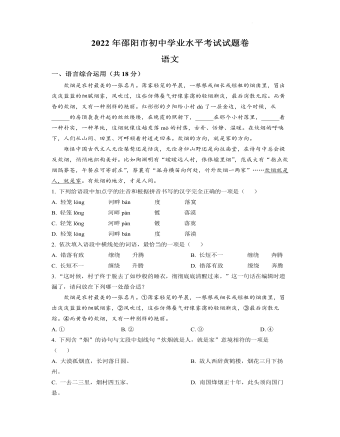
2022年湖南省邵阳市中考语文真题(原卷版)
嗟夫!予尝求古仁人之心,或异二者之为,何哉?不以物喜,不以己悲,居庙堂之高则忧其民,处江湖之远则忧其君。是进亦忧,退亦忧。然则何时而乐耶?其必曰“先天下之忧而忧,后天下之乐而乐”乎!噫!微斯人,吾谁与归?

2022年江苏省宿迁市中考英语真题 (原卷版)
Theoil paper umbrella is a traditional Chinese handicraft(手工艺品).It has a history of over 1,000 years in China.In early TangDynasty, it was introduced to Japan and Korea, so it was called the “TangUmbrella”. Later oil paper umbrellas were spread to other Asian countries, suchas Vietnam, Thailand and Laos, and each had its own style. However, assteel-ribbed(钢骨的)umbrellas appeared in the last century, thehand-made oil paper umbrellas became less used in daily life. They were turnedinto decorative artifacts(装饰性工艺品).
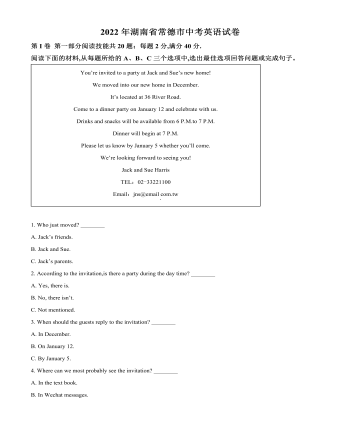
2022年湖南省常德市中考英语真题(原卷版)
Bike-to-Work Day is held every year across NorthAmerica on the third Friday of May. It was started by the League ofAmerican Bicyclists in 1956. Its aim is to promote (促进) the bicycle as a seriouschoice of getting to and from work. In today’s world where global warming is aserious issue, the bicycle is a perfect way of reducing our carbon (碳) footprint.
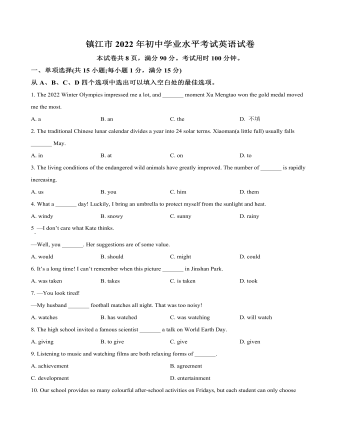
2022年江苏省镇江市中考英语真题(原卷版)
The fantasticman-made “forest” is a Singapore landmark. It is made from steel and concrete(水泥) covered in localflowers and plants. At night, 18 solar-powered tree-like towers which get theirenergy from the sun often light up the city.
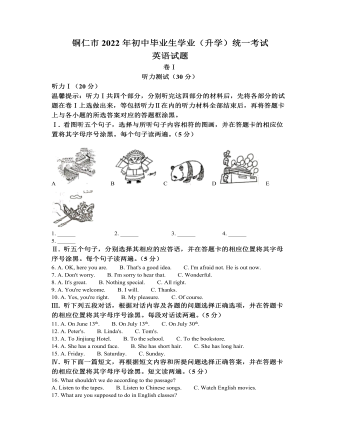
2022年贵州省铜仁市中考英语真题(原卷版)
Bill doesn’t like doingfamily housework at all. He likes to play with his friends in the park.Bill asks his four friends about their housework.Bill: What do you have to do at home, Dan?
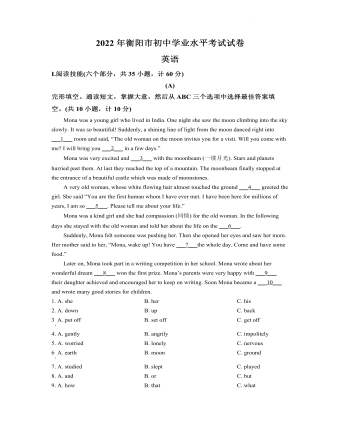
2022年湖南省衡阳市中考英语真题(原卷版)
The boy named Li Banghua is from Hefei. AnhuiProvince. He made the plane completely by himself. The plane is 0.6 meterswide, has a wingspan (翼展) of 4.4 meters and weighs about 40 kilograms.According to a local report, Li just finished his high-school entrance exam ayear ago and got good grades.
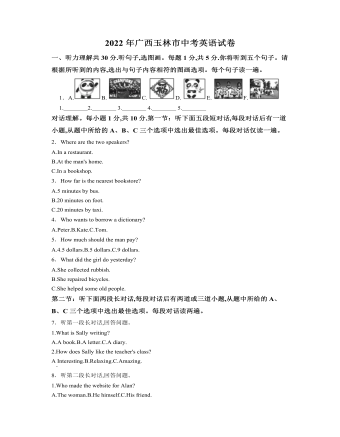
2022年广西玉林市中考英语真题(原卷版)
Lu Junling, a security guard from Hebei University, became popularon the Internet. As an ordinary (平凡) person, though Lu Junling is more than 50 years old, hememorizes English vocabulary for CET 6 under the street lights every day justto improve himself. When he is free, he also writes novels and sings operas.That’s not all! Painting, music, kongfu, ancient poems, etc. are all hishobbies. So a number of people call him “treasure security guard (宝藏保安)”. Lu Junling said, “If I want to become an artist, I will alwayswork hard for my dream!” Mr. Lu’s words live in many people’s memory.
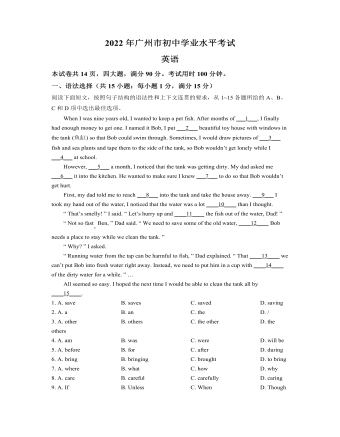
2022年广东省广州市中考英语真题(原卷版)
Slowlybut surely, Amy and her grandparents were making progress. Boxes of all sizeswere placed on top of each other throughout the house. Amy’s grandparents hadlived in the house for years and they had collected many things.
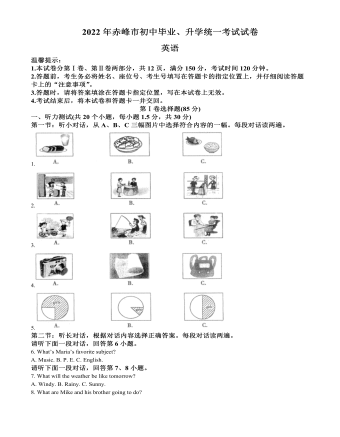
2022年内蒙古赤峰市中考英语真题(原卷版)
We allknow that rice, wheat and corn are staples, but do you know there is anotherkind of staple food—potatoes? Potatoes have many advantages. Theyare a good source of vitamin C and potassium(钾). A potato’s vitamin C isas rich as 10 apples. What’s more,potatoes are low in calories(卡路里)-onlythree fourths of the same amount of wheat and corn, according to People’s Daily. Potatoes are easy togrow. It can be grown in both the north and the south during winter, spring andautumn. The plant is also able to bear drought(干旱). Some areas of China arefacing water shortages, so the potato is safe to grow.
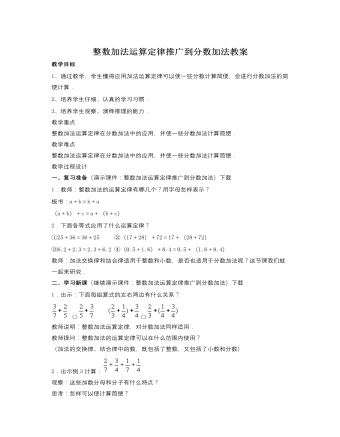
人教版新课标小学数学五年级下册整数加法运算定律推广到分数加法教案
教学目标1、通过教学,学生懂得应用加法运算定律可以使一些分数计算简便,会进行分数加法的简便计算.2、培养学生仔细、认真的学习习惯.3、培养学生观察、演绎推理的能力.教学重点整数加法运算定律在分数加法中的应用,并使一些分数加法计算简便.教学难点整数加法运算定律在分数加法中的应用,并使一些分数加法计算简便.教学过程设计一、复习准备(演示课件:整数加法运算定律推广到分数加法)下载1.教师:整数加法的运算定律有哪几个?用字母怎样表示?板书:a+b=b+a(a+b)+c=a+(b+c)2.下面各等式应用了什么运算定律?①25+36=36+25 ②(17+28)+72=17+(28+72)③6.2+2.3=2.3+6.2 ④(0.5+1.6)+8.4=0.5+(1.6+8.4)教师:加法交换律和结合律适用于整数和小数,是否也适用于分数加法呢?这节课我们就一起来研究.二、学习新课(继续演示课件:整数加法运算定律推广到分数加法)下载1.出示:下面每组算式的左右两边有什么关系?
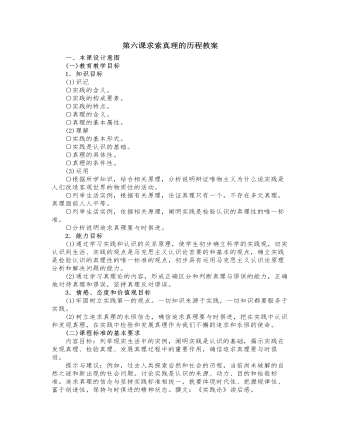
人教版高中政治必修4第六课求索真理的历程教案
农业科学的周期是以年为时间单位,一次实验就要等到一次花开、结果。就这样,几个实验误导了袁隆平好几年。这时登在《参考消息》上的一篇不起眼的文章像给迷途中的袁隆平以当头一棒:克里克、沃森和威尔金斯发现DNA螺旋结构,西方的遗传学研究进入分子水平。“我当时还在那里搞什么无性杂交,糟糕得很”。水稻是自花授粉植物,雄蕊雌蕊都在一朵花里面,雌雄同株,没有杂种优势一杂种优势是生物界的普遍现象,小到细菌,大到人,近亲繁殖的结果是种群的退化。但是水稻因为花小,其杂交是当时公认的世界难题,设在马尼拉的世界水稻研究中心就是因为困难重重,差点关闭。袁隆平偏不信这个邪,他突发灵感:专门培养一种特殊的水稻品种——雄花退化的雄性不育系,没有自己的花粉,这样不就可以做到杂种优势了吗?于是,漫长的寻找过程开始了,要找到这样一株雄花退化而且杂交之后产量猛增的“太监”水稻简直是大海捞针。
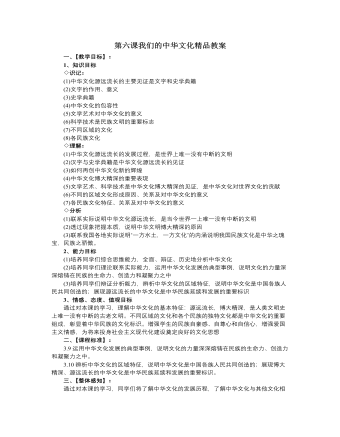
人教版高中政治必修3第六课我们的中华文化精品教案
(三)、中华之瑰宝.民族之骄傲1.我国各具特色的民族文化异彩纷呈.都为中华文化的形成和发展做出了重要贡献(1)我国的雕刎建筑艺术是各族人民共同创造的,都是中华文化的瑰宝。例如:敦煌石窟、云冈石窟;克孜尔千佛洞等,是古代的汉族、鲜卑以及西域各族的艺术家和劳动人民共同创造的。(2)许多少数民族用自己的语言文字创造了优秀的民族文学。例如:藏族的《格萨尔王传》、蒙古族的《江格尔》和柯尔克孜族的《玛纳斯》被并为三大英雄史诗。◇注意:民族文化深深地体现着各民族的风俗和精神面貌,通过一定的物质展现,可以表现在建筑、民族文学、舞蹈、习俗、信仰、衣着等方方面面。◇点拨:“相关链接”中提到的《江格尔)是蒙古族卫拉特郝英雄史诗。史诗的篇幸结构、故事情节、语言风格等具有蒙古族说唱艺术的特点。从民族文学角度反映了本民族的文化生活.同时也为中华文化增添了绚丽色彩。◇课堂探究:(1)你还知道哪蝗少数民族舞蹈?它们务有什么特点?
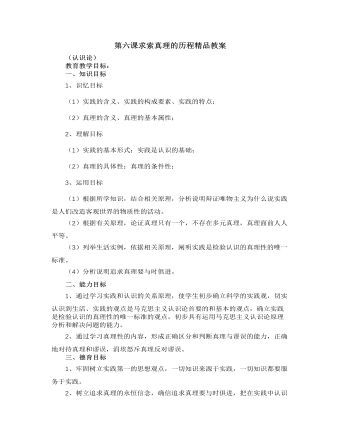
人教版高中政治必修4第六课求索真理的历程精品教案
二、分析题基于非典型肺炎防治的需要,武汉大学和中国科学院微生物研究所,集中优秀人才和先进的仪器设备,以科学的理论为指导,运用现代的知识与技术手段,对SARS病毒进行深入细致的研究。2003年5月,他们联合研制出抗击SARS病毒侵入细胞的多肽药物。经科学试验证明,它可以阻断SARS病毒侵入人体细胞,具有预防和治疗两种功效。这些药物的发明在非典型肺炎的预防和治疗发挥着重要的作用。上述材料体现了辩证唯物主义认识论的哪些观点?答案提示:体现了实践是认识的来源、实践是认识发展的动力、实践是检验认识的真理性的唯一标准、实践是认识的目的和归宿、认识对实践具有反作用等辩证唯物主义认识论的观点。三、辨析题1、“仁者见仁,智者见智”的说法否定了真理的客观性答案提示:(1)此观点错误。(2)“仁者见仁,智者见智”是说对同一事物不同的人有不同的见解。
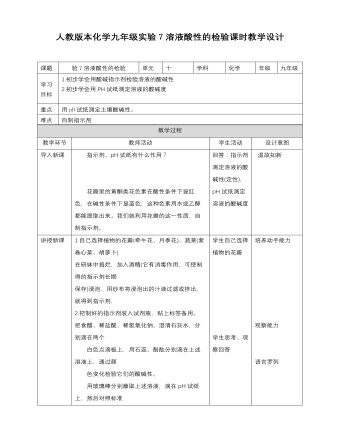
初中化学人教版九年级下册《实验活动7溶液酸碱性的检验》教案
1.自己选择植物的花瓣(牵牛花、月季花)、蔬菜(紫卷心菜、胡萝卜) 在研钵中捣烂,加入酒精(它有消毒作用,可使制得的指示剂长期 保存)浸泡,用纱布将浸泡出的汁液过滤或挤出,就得到指示剂, 2.把制好的指示剂装入试剂瓶,贴上标签备用。 把食醋、稀盐酸、稀氢氧化钠、澄清石灰水,分别滴在两个 白色点滴板上,用石蕊、酚酞分别滴在上述溶液上,通过颜 色变化检验它们的酸碱性。 用玻璃棒分别蘸取上述溶液,滴在pH试纸上,然后对照标准 比色卡比较,得出pH值,也就是酸碱度。 把上述溶液滴在白色点滴板上,用滴管吸一下你自制的指示剂,滴在滴板的溶液里,观察颜色变化,每用一种指示剂,换一下滴板的溶液。 把所得到颜色变色变化的信息和pH值数据填入教材第70页的表中。 3.取少量土壤样品,将土壤样品与蒸馏水按1∶5的质量比在烧杯中混合, 充分搅拌后静置,用玻璃棒蘸澄清的液体,滴在pH试纸上,然后对照 标准比色卡记录读数。

人教版新目标初中英语七年级下册How was your weekend教案2篇
Teaching Goal:1. General aims:Talk about recent past events2. Particular aims:A. Language Focus.Talk about recent past events and think of the past events.B. Language goalsHow was….?It was …What did …do over the weekend?C. Language structures:(1). How was your weekend? I was great. Pay attention to no form.(2). What did you do over the weekend? I played soccer. We went to the beach.D. Useful words and phrases:Words: was, did, went, beach, over, project, test, wasn’t, false, number, geography, spend, week, most, mixture, their, had, little, cook, read, saw, change, everyone, sit, sat, no, anythingPhrases: did one’s homework, played soccer, cleaned my room, went to the beach, played tennis, went to the movies, on Saturday morning, over the weekend, cook … for, what about, do some reading, have a party, talk show, go shoppingE. Grammar language:Present simple past tenseRegular and irregular verbsF. Learning strategies:Tour and holidaysG. Interdiscipinary:H. Emotion and manner:Teaching time: 5 periodsTeaching procedures:Period One教学步骤、时间 教师活动 学生活动 媒体应用Step 1Free talk 3’ Ask some questions like:Who’s on duty today?What’s the weather like? Answer and talk about something.让同学们回答下列问题1. Do you like weekend? (Let some students answer)It takes them three minutes to talk about the question.2. Why do you like weekend? (let the students answer) Most of the students like the weekend此时教师用汉语问:“在周末期间问你干了什么?这句话用英语这么回答?Let the students guess.At last the teacher give them right answer3. What did you do over the weekend?(板书、学习)

人教版新目标初中英语七年级下册What does he look like教案3篇
所需要用到的句子:Who is that?That is Jack. I like him.Why do you like him?I like him because he is interesting.Task 4: 设计理想中的人类Step one: 设计理想中的人类的外貌。把全班同学分成若干小组,学生可以边说边在纸上画出他们的模样。Step two: 设计理想中人类的性格。学生们可以把那些能描述性格的单词写在图画的旁边。Step three: 每组选出一名同学,其他同组同学提问,他作简单回答,并说明原因。所需用到的句子:What does he or she look like?He or she ...What is he or she like?He or she is ...Why?Because ...Task 5: 挑战性活动调查性格是天生的还是后天形成的,让每个同学回家去调查一下自己成长过程中性格是否有变化,具体是怎样的,为什么会这样? Teaching Aims:1. Enable students to have a general understanding of how to talk about people's physical appearance.2. Enable students to tackle some essential vocabularies and patterns about describing people. Provide them with necessary skills and methods.3. Create various chances for students to describe the persons they're familiar with, such as classmates, family members, teachers, idols, etc.

人教版新目标初中英语七年级下册Where is the post office教案2篇
Period 2 (3a----Section B 2c)Preview(Pre-task): Key points: What laAdd another information about their pen pals----their language on the cardnguage does she/he speak?She/He speaks....Does she/he have any brothers and sisters? Does she/he speak English?Preview(Pre-task): Add another information about their pen pals----their language on the cardKey points: What language does she/he speak?She/He speaks....Does she/he have any brothers and sisters? Does she/he speak English?Step 1 Revision1.Revisionand dictation of the new words 2.Revise the drills they learned yesterday.(by pairwork and grammar exercise)Step 2 Leading-inT has a conversation with one student. The conversation is following:---Do you have a pen pal?---Yes, I do.---What's your pen pal's name? ---His/Her name is....---Where is your pen pal from? ---He/She is from...---Where does he/she live? ---He/She lives in....---What language does he/she speak?He/She speaks...Write the new words on the Bb. They are following: EnglishChineseJapaneseFrenchStep 3 LearnLearn the new words with the whole class.Finish 3a with the students3b Pairwork T still does an example with one student Then the Ss practise in pairs. The example is following:--Curry Muray is my pen pal. He is from the United States.---What language does he speak?

人教版新目标初中英语七年级下册I ’d like some noodles教案
教学过程Step 1: warming-up Sing a song---------“food and drink” Step 2: Revision1 Dictation2 Revise: What kind of noodles would you like?I’d like …What size bowl of noodles would you like?I’d like…Step 3: Presentation1 show pictures of food, ask students say the words.2 Students read the newspaper ad in 3a. Fill in blanks with words in the box. Then read the ad together, the teacher explains some difficult language points.3 Check the answers Step 4 PracticeAsk students to finish 3b in the same way according to 3a. Students read the short passage and fill in the blanks .At last, check the answers.Step 5 productionAsk students to write their own ad for dumplings, noodles, drinks, and other foods they know. Then ask students to read their partner’s ad. Then order food and drink from their partner.Step 6 Home workGroup work – make an ad about “food and drink”

人教版新目标初中英语七年级下册It’s raining教案2篇
1 Each group choose one place to describe and what you are doing in it Choose one place, and describe what they are doing 2 Move around the room and give suggestions Talk about it and write it down 3 Ask one to show their works and act it Choose one of each group to make a report 4 Evaluate the best group and the best reporter Choose the best one Homework Ask your friends their ideal place and write about it教学反思:新课程标准中强调学生在课堂中的主体地位,在综合课中他们的主体地位就更加突出。在各个活动中给不同程度的学生不同层次的任务,让各层面的学生都有表现发挥的机会,从而产生对英语的兴趣。使用照片图片多媒体来辅助教学,效果更好。同时让了解其他国家风景,风俗的同学介绍ideal place,增加学生的背景知知识,实现跨学科交流的目的。教案点评:采用任务型教学模式,在各个活动中给不同程度的学生不同层次的任务,让各层面的学生都有表现发挥的机会,从而产生对英语的兴趣。使用照片图片多媒体来辅助教学,效果更好。让了解其他国家风景,风俗的同学介绍ideal place,增加学生的背景知识,实现跨学科交流的目的。

人教版新目标初中英语七年级下册Where did you go on vacation教案
句型: Where did you go on vacation? I went to summer camp.Did she go to Central Park?Yes,she did.No, she didn’t语法:一般过去时特殊疑问句、一般疑问句及肯、否定回答。课时安排4课时第一课时:Section A:la,1b,lc,2a,2b,2c 第二课时:Section A:3a,3b,4第三课时:Section B:1,2a,2b,2c第四课时:Section B:3a,3b,3c,4 and Self Check第一课时教学目标掌握描写假期生活的形容词。假期里自己所做事情的简单表达。谈论假期做的事情及当时情况。谈论假期时旅游的天气,旅游者以及食物等。教学过程一、导入播放一首英文歌曲:Let’s travel 说明:通过让学生听节奏欢快迪斯尼英语歌曲Let’s travel.引入本节课谈论的话题vacation and travel. 让歌曲使学生的思维活跃,增强课堂气氛,激发学生提高学习英语的兴趣。T:How is the trip ?Ss : It’s pretty good/ happy/exciting /relaxing/busy/dangerous/ fantastic说明:这个问题是为了操练形容词。建议让多个Ss作答。鼓励他们用不同的形容词。上述个别形容词本应在第二课时中出现,但可以在warming-up中第一次非正式出现。这些形容词也可在老师的评价语中适时出现,以加深学生对词汇的印象。